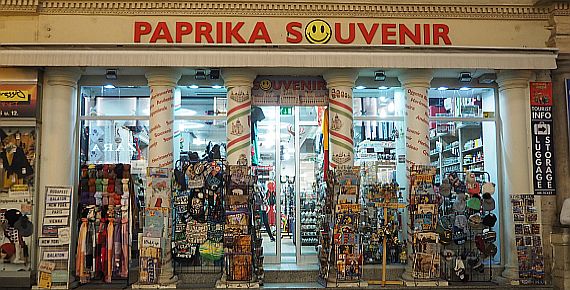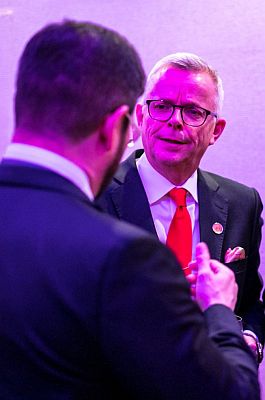4th HOTCO Budapest with legacy issues and new chances for CEE and SEE
 |
| From a souvenir kiosk to a highstreet shop: This colourful shop in a top location in the pedestrian zone reflects the transformation of Budapest. / Photo: map |
Budapest (January 31, 2020). "Emerging Europe" turns 30 this year. "And the countries have changed, from imitation (of the west) towards innovation," said market expert Andrew Wrobel, describing the impressive change at the Hotel Investment Conference (HOTCO) in Budapest last week. This is especially apparent in the Hungarian capital, the gate to Southeast Europe. The B2B platform also showed that the challenges move from west to east, as well as the discussions.
It was the 4th investment platform hosted by Horwath HTL Hungary and it attracted more than 400 participants from 38 countries. Stephan Interthal, General Manager of the hosting Kempinski Corvinus Hotel Budapest, was also impressed by that; he has been a supporter of HOTCO for four years now. The conference floor and gallery provided ideal layout requirements for a communicative event (see also short interview with Interthal below).
Budapest has become the interface between Western and Eastern Europe, which had been apparent at the conference by the presence of the largest international chains, various investment companies and already some individual investors from the Far East. Central Eastern Europe (CEE) and South Eastern Europe (SEE) are economically thriving, the opportunities are immense.
However, many "buts" accompany this positive forecast: The legal situation remains challenging in CEE/SEE, as well as the massive staff shortage. 40% of the young people have left their countries, as Andrew Wrobel, Founding Partner of the internet platform Emerging Europe noted, "and this will not become any better." It has to be true as every panel discussion complained about the industry's HR shortage, without any prior consensus.
From a political viewpoint, numerous countries in the region are still in the waiting queue for the EU (e.g. Montenegro, Serbia, Bosnia-Herzegovina, Ukraine, Belarus); this way, they are forced to undertake reforms – also to become independent from "common" things such as Russian gas: The air in the most beautiful cities is heavily polluted, as one speaker pointed out. Regarding tourism, it sounded as if massive opportunities and massive problems offset one another.
 |
|
| Detailed discussions in smaller groups at the end of the conference day: This was about Hungary. / Photo: Horwath HTL Hungary |
Building costs
a burden to all
Nearly all the large chains were present: Accor, Choice, Hilton, IHG, Louvre, Marriott, Orbis, Radisson, Vienna House, Wyndham. They all made similar remarks to those made at Western conferences: Each has sufficient brands and agreement types to be able to equip all locations respectively. Striking was that all discussion participants mentioned quickly rising building costs in the region very quickly so that "everything is about matching the development costs with the suitable brand and its RevPAR," explained Miguel Martins, Development Director Eastern Europe & Turkey of IHG. Marriott developer Janusz Mitulski, Senior Director CEE & Ukraine, added dryly: An increasing number of investors is less driven by emotions, they are looking at the figures more than ever before – even when they have found great locations for conversions and are euphoric about them.
Ratio prevails, from west to east. Therefore, it was very bizarre to hear that even global players are interested in tiny project dimensions – as they state themselves: Accor and Hilton are looking for hotels starting at 30 rooms, IHG and Marriott starting at 50, Wyndham at 60-70 rooms.
CEE, SEE, the GUS/CIS states and the Caucasus, all these nations provide a colourful mixture of countries with a lot of (uncontrollable) countryside – only few cities, various degrees of corruption and lacking compliance. Georgia has repeatedly been mentioned as a country with a convincing development. Amongst the cities, Budapest was the star.
More guests, overnight stays, rooms, brands
For years, the Hungarian tourism development constantly pointed upwards.. In 2018, the country saw record-breaking numbers of travellers, according to the National Tourism Agency, based on figures by the Central Statistics Office. Two years ago, commercial lodgings around Hungary registered 12.5 million guests, an increase of more than 5% when compared to 2017. The country registered 31 million guest nights in 2018 – one million more compared to 2017. The two most popular destinations were Budapest and Lake Balaton. The main tourism drivers are the airlines. Budapest Airport has announced further investment plans, including the construction of a new terminal building by 2024.
 |
|
| Attila Radvánszki: New brands make the market more sophisticated. / Photo: Horwath HTL Hungary |
So the Hungarian capital, which by the way is situated at the same latitude as Milan, is attracting more and more tourists. No wonder that the big chains were present at HOTCO. Attila Radvánszki, Director of Horwath HTL Hungary, highlights that the wide range of brands coming to the city will make the market more sophisticated, creating ultimately added value to the visitors coming to Budapest. Brands announced will range from Jo & Joe to Radisson Collection and everything inbetween. HOTCO insiders mentioned further concrete brand names to come, such as St. Regis, W, Edition, Tribe, Pestana, Eurostars, H2, Ramada and Quality Inn.
Based on the information received from Horwath HTL Hungary, there are just over 50 projects comprising 5,700 keys in the pipeline in Budapest with high probability of materialising within the next 5 years. Though delays could easily span this time horizon to a few years more. The active interest for the Hungarian capital is also underlined by the 20 "speculative" projects on top of the 50, which are still in early phase of planning and might change function or have been idle for a few years now.
The big brands are also targeting the more rural regions: As a first step, most of them plan to place their mid-range brands in the larger secondary cities. Attila Radvánszki notes that the so-called "Kisfaludy Programme", which the state launched in 2017 and which is still running, could even increase the number of new entrants to the countryside, but remains skeptical at the same time: "The fact that a group wins a pitch and receives CAPEX funding for it does not necessarily mean that the money will also go into a project immediately. The constantly rising development costs make it difficult for project owners to structure financing, which inevitably leads to massive delays."
In the countryside approximately 40 projects with 3,700 keys are in the pipeline till 2024 in varying state of development, with notably smaller average size than the ones in the capital. Key destinations remain the Lake Balaton area, as mentioned above, including the thermal destinations around it and major cities like Győr, Miskolc and Debrecen. / Maria Pütz-Willems
|
Boomtown Budapest 4 questions to Stephan Interthal, GM Kempinski Corvinus Budapest
I'm very happy in this lively, young city, which has seen lots of positive developments lately. I was already here between 1997 and 2004, but today, Budapest is a very different city that has developed greatly over the past 20 years. The financial crisis of 2009 has been overcome and since 2014, there has been a clear upward trend. Kempinski Corvinus Budapest looks back on five record years since then. Revenue and profit have increased in the same period. In 2019, we managed an average occupancy of 72%, while the average ADR was at 180 euros net.
How is the hotel scene developing in the city? There is healthy competition, particularly in the luxury segment, in which the Four Seasons Hotel has been the RevPAR leader for years. However, we are also moving high up. The hotel is in top condition, we are constantly renovating and have invested around 18 million euros together with our owner since 2015. In addition, Kempinski has a network that has grown. We were the city's first luxury hotel when we opened in 1992. What hotels from the next segment will try to put pressure on the luxury segment? The number of 4-star hotels has indeed grown significantly in recent years, but has remained largely rooted in the traditional hotel industry and thus in traditional design. There are numerous privately operated 4-star hotels that are all successful. Similar to other cities, this young destination also requires international, young and upbeat brands – for example like 25hours, Indigo, Andaz, or Vienna House. I think a colourful hotel mix will keep Budapest and Hungary high on the list as a destination. You have been in Budapest for a total of 12 years with a 10-year break in between. How has the employee situation changed? Many years ago, GMs were still able to hire their employees "off the street". Today, we have virtually full employment, at least in Budapest. We ourselves have not been poaching from our competitors for a long time now. Instead, we find employees and talents who are interested in the hotel industry in all kinds of sectors, e.g. in retail. We are looking for talent as skills can be trained. |
To print this article you have to be registered and logged in for newsletter, visitor or subscription.






